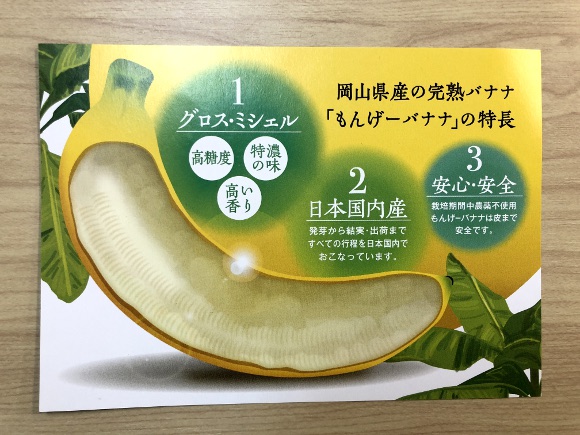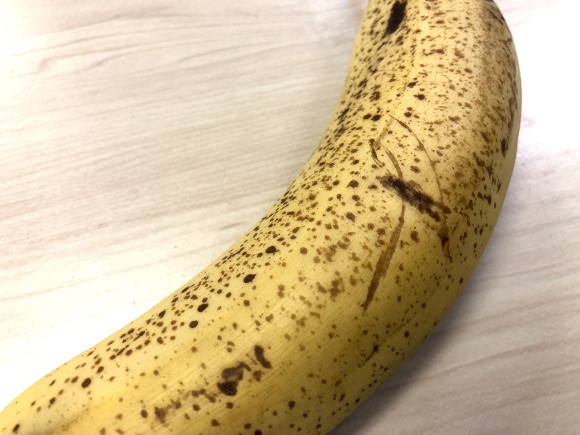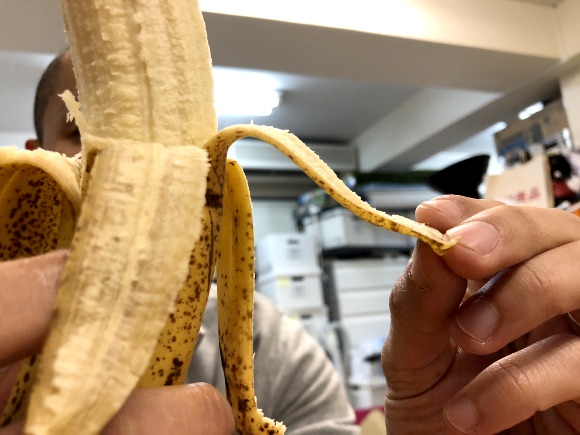If you’ve ever been to a Japanese department store in August, when they’re selling mid-year gifts, you’ll know that fruit can fetch some pretty high prices in Japan. High-end fruit can cost upwards of the equivalent of 10,000 yen, and at any time of the year, even basic grocery store fruit like apples and pears can, for certain varieties, cost 200 to 300 yen each. Nevertheless, fruit makes up a delicious part of Japanese food culture, but what would you think is the most consumed fruit in Japan?
The banana, of course! It’s no wonder since it’s easy to eat, cheap, and tasty. Japan imports 99 percent of their bananas from overseas, but part of the one percent that is produced in Japan is the Mongee Banana (pronounced “mon-gay”).

The Mongee Banana is a very special banana. It’s only grown in Okayama Prefecture, and they only sell 10 bananas per week. One banana costs 648 yen, but the most interesting thing about this banana is that you can eat the skin!
We were able to get their hands on some of these bananas, so they gave them a taste test. What does an edible banana peel taste like? Let’s find out!
About the mystical Mongee Banana
Mongee Bananas are produced at D&T Farm in Okayama Prefecture, in western Japan. Typically bananas only grow in tropical climates, but D&T Farms uses a method called “Freeze Thaw Awakening”, which extracts and implements the DNA of fruits in order to produce specimen similar to ancient times, which then allows them to be grown in a cooler climate. Bananas produced in this way were successfully grown for the first time in November.

Since they’re raised in a non-tropical climate, they don’t have any natural predators, which means no pesticides are used and Mongee Bananas are organically grown. They’re sweeter than regular bananas, with 24.8 grams of sugar, as opposed to the average 18.3 grams. Because of that, they’re also stickier and have a much stronger smell. That’s probably why they gave it the name “Mongee”, since “mongee” is Okayama slang for “incredible”.
You can only find Mongee Bananas in the Fruit Corner of Tenmanya Okayama, an Okayama department store. They only get one shipment per week of just 10 bananas, but they were generous enough to send us some for tasting.
The first thing we noticed: The skin is very thin
Actually, before we could eat the bananas we had to wait for them to ripen. Apparently, they’re only ready to eat when you start to see little brown dots on the surface of the skin, unlike regular bananas, which are ripe before this stage. The Mongee Bananas took about two days after arrival to ripen. Meanwhile, the smell was getting stronger and more tempting.

Once it was ripe, Japanese-language correspondent P.K. Sanjun’s first inclination was to bite straight into the banana, but he suppressed his animal desires and first tried it like a regular banana. Upon peeling it he realized that the skin is relatively thin compared to a regular banana, so he thought it was reasonably edible-looking.

With a rising excitement he bit into the fleshy innards of the banana…and found it has a very strong tropical flavor. P.K. even said it’s almost pineapple-like, with a scent that just wafts right up through your nose to hit your taste buds. It’s definitely not a normal banana.
The edible skin
Next the crew wanted to try the skin, so P.K. sliced up another banana with the skin still on. On the first bite we noticed that the skin is fairly easy to eat. Since it’s very thin, there’s no strange texture, and compared to the sweetness of the banana there isn’t much flavor to the skin. So the Mongee Banana truly does have an edible skin. Mongee!!

P.K. was the only one brave enough to just eat the skin…he said it was bitter, but not inedible.
To really understand how special the edible skin was, P.K. went to the convenience store and bought an ordinary banana, imported from Ecuador, with the intention of trying the skin. But that was a mistake…it was far too tough and fibrous, and the flavor was far more bitter and astringent. Conclusion: regular banana peels are not meant to be eaten. They might also be covered in pesticides, so we really don’t recommend eating them.
So let it be known, the Mongee Banana is definitely special! This top class, genetically enhanced, tropical-flavored banana is probably going to be difficult to get your hands on, but if you find yourself in Okayama, be sure to take a peek in Tenmanya. These bananas are really “mongee”.
Read more stories from SoraNews24.
-- Live with parents or burn through your savings? Survey of young anime workers draws bleak picture
-- Japanese convenience store’s fried chicken pizza burger is a some-assembly-required masterpiece
-- Otaku woman in Japan finds herself target of strange fake shoplifting scam, netizens urge caution
- External Link
- https://en.rocketnews24.com/2017/12/21/this-super-rare-japanese-banana-has-edible-skin%E3%80%90taste-test%E3%80%91/
 Take our user survey and make your voice heard.
Take our user survey and make your voice heard.




4 Comments
Login to comment
Kobe White Bar Owner
All bananas have edible skin its just if you choose to eat it.
Nan Ferra
Never gonna eat a skin covered in black spots....what about smoking it though? A bit like the "Mellow Yellow" phase and Donovan song from the 60s
gaijintraveller
What about apples with edible skin produced in Japan? When I lived in Britain, I thought it was quite normal to eat the skin of apples, yet no one does in Japan. I was told it was because apples are waxed or there is too much pesticide in the skin.
Luddite
I eat the skin of most fruit and vegetables. I find it bizarre that in Japan very few people do this, especially with grapes. It's so wasteful.